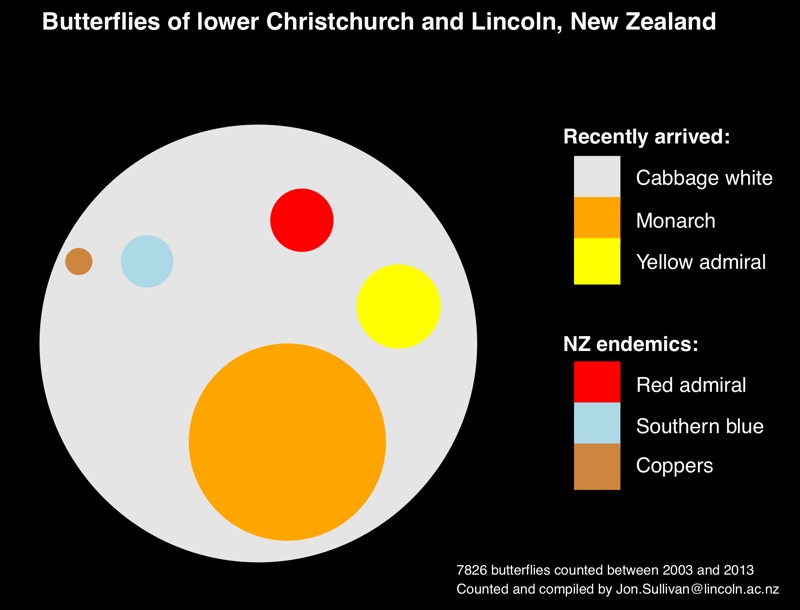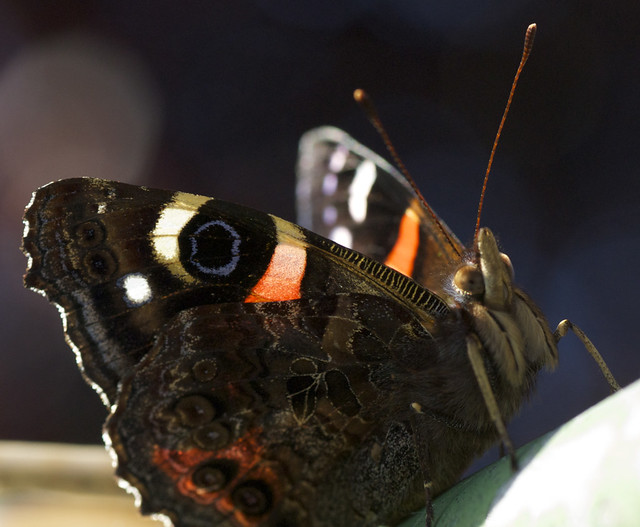RECENT ARTICLES
- CEBRA: An optimised and standardised sampling protocol for BioBlitz
- Stop it people, the plural of anecdote IS data!
- That's no pollinator, that's a flower visitor
- Add a scale to your macro photos
- What to photograph when counting the wild
- Imagine counting the wild on EVERY street in a city!
- My wild counting workflow
- A butterfly flew through
- Why iNaturalist observations without photos can be research grade
- Why you shouldn’t use a spreadsheet for data entry
- All articles ...
Exotic butterflies dominate in Christchurch
96.9% of the butterflies in the built parts of New Zealand’s Christchurch city are species that have arrived since European settlement.
written Dec 17, 2013 • by Jon Sullivan • Category: Wild Changes

Through a naturalist’s eyes, Christchurch city is a habitat thoroughly dominated by naturalised exotic species, whether it be the weeds in gardens or the birds in the trees. This is especially true for the lower Plains suburbia and surrounding farmland, away from the coastal wetlands and beyond the Port Hills. The city and surrounding rural landscapes are far distant from the forests and wetlands they replaced. It’s no surprise that this has put the resident natives on the back foot. Butterflies are no exception.

Two things leap out. One is that there are very few butterfly species in this landscape. New Zealand has few butterflies already, and species like the tussock butterflies and boulder coppers, while still found in some lowland wild places in inland Canterbury, are exceptionally rare to gone in the Christchurch and Lincoln areas.
The other stand out point is that the recently arrived species dominate, and almost completely. The naturalised European cabbage whites (Pieris rapae) and the naturalised American monarchs (Danaus plexippus) together account for 94.0% of the butterflies I’ve seen. Adding the Australian yellow admirals (Vanessa itea) brings it to 96.9%.
(Lepidopterist Brian Patrick is convinced that yellow admirals established in New Zealand after people, since he saw them arrive and spread through the southern South Island when he was younger. This makes yellow admirals native, just like silvereyes and spur-winged plovers, since they all presumably flew from Australia on their own. However, they are still recent additions to New Zealand caused by the major land use changes following human settlement.)
The endemic butterfly species, being New Zealand’s unique red admiral, kahu kura (Vanessa gonerilla), southern blue (Zizina oxleyi), and copper species (two Lycaena species locally), together make up only 3.1% of the Christchurch and Lincoln butterflies. That’s a tiny fraction.
The huge dominance of the naturalised butterflies can be explained at least in part by their host plants. Cabbage white butterfly caterpillars feed on cabbages and broccoli and other planted Brassica species as well as their widespread weedy relatives like wild mustards. Monarchs only feed on exotic milkweeds like swan plants (Gomphocarpus species). New Zealanders are particularly fond of these butterflies and a lot of people plant swan plants in their gardens just to feed the monarchs. Very few people purposely cultivate the common weedy European nettles like Urtica urens that the caterpillars of yellow admirals feed on, but these nettles thrive in the city despite people’s weeding efforts.
In contrast, the coppers feed exclusively on native Muehlenbeckia vines, which are rare in the suburban and rural landscapes around Christchurch and Lincoln. On my regular run route through the suburbs of Hoon Hay, Somerfield, and Wigram, I know of only three Muehlenbeckia plants, all Muehlenbeckia australis. One is growing amongst the riparian plantings of the Wigram retention basin and two in gardens. Muehlenbeckia do, however, remain common in the Port Hills by Christchurch and in these places coppers are still common.
Red admirals prefer the endemic (and vicious!) tree nettle, ongaonga (Urtica ferox), which remains common in the wildlands of Banks Peninsula, where red admirals also remain common. Red admirals do occasionally feed on the smaller herbaceous nettles while yellow admirals have rarely been recorded feeding on ongaonga. Red admirals are also heavily parasitised, including by an early biocontrol introduction of a parasitoid wasp (Pteromalus puparum) targeting cabbage whites.
Increasing the pretty little coppers in Christchurch could be as easy as planting more Muehlenbeckia. Likewise, planting ongaonga in out of the way places through Christchurch (and perhaps as a theft deterrent!) could well increase the red admiral numbers substantially. Monarchs make up 17% of all butterflies in Christchurch and Lincoln and are entirely reliant on short-lived plants being repeatedly planted in people’s gardens. This suggests that raising the numbers of our endemic butterflies here could easily be as trivial as planting more of the right plants.
I remain more confused about the rarity of the southern blue, since it has been recorded feeding on a wide range of legumes including many exotics. I expect its rarity is a combination of preferring undisturbed, open habitats and being more reliant on native legumes than its host list suggests, such as the native brooms (Carmichaelia species).
The challenge in front of us is to turn things around and bring endemic butterflies back to people’s gardens in Christchurch and Lincoln. It could well be an ecologically easy thing to do, if enough people want to do it.

You can download the R script and summary data that made the circle graph here. There are some clear patterns in space and time in this data (e.g., coppers and blues are exceptionally rare in suburban gardens on the flat in Christchurch but more common in some peri-urban rural areas). I will delve into these patterns in later posts. One possible pattern I don’t have a good feel for yet but am keen to analyse is whether the numbers of red admirals fall off with distance from the Port Hills, consistent with them dispersing out from the ongaonga-rich Port Hills reserves. There are also strong seasonal patterns and annual changes. A sizeable fraction of my observation data from the past five years are still sitting as untranslated field shorthand in my database (e.g., ra 1 means one red admiral, cwb 3 means three cabbage white butterflies). I’m looking forward to getting stuck into all this once I’ve finished writing and running my shorthand translation scripts.